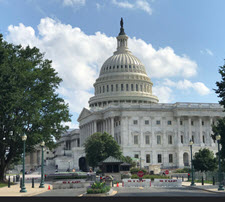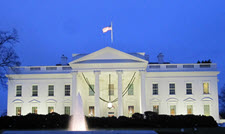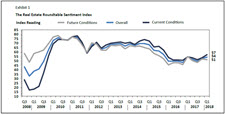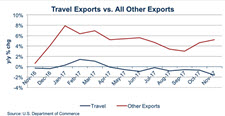During a week of thousand-point gyrations in the stock market and last-minute congressional votes to keep the government open, President Trump this morning signed a budget deal into law that ended a nine-hour government shutdown. [Bipartisan Budget Act legislation (H.R. 1892)]
The budget deal and spending measure – which passed the Senate today just before 2:00 AM, followed by a narrow approval vote in the House about 5:30 AM – includes:
 |
The Congress passed the budget deal and spending measure early on the morning of Feb. 9, hours after the government technically shut down. |
Another short-term Continuing Resolution funding the government through March 23;
An increase in the debt ceiling that is expected to last one year, addressing the matter until well after the mid-term elections;
An agreement to increase budget caps – and significantly increase spending – by $320 billion over the next two years, split between defense and non-defense domestic spending;
Disaster relief funding and renewal of a slew of expired tax provisions. (The bill does not address the controversial DACA issue – the status of immigrants brought to the U.S. as children.)
Although the measure includes a clean, one-year retroactive extension of the Section 179D tax deduction for energy efficient buildings through 2017, it does not include any technical corrections to the landmark tax overhaul enacted in December. Those corrections are expected later this year in separate legislation.
 |
Next, President Trump is scheduled to submit the Administration’s 2019 budget proposal as House and Senate appropriators begin work on 12 bills that may fund the government beyond March 23 – until the remainder of FY2018 through September 30. |
The Senate Finance Committee released its Summary of the Tax Extenders Agreement explaining the extension of several temporary tax provisions. The Joint Committee on Taxation issued JCX-4-18, estimating that the tax provisions in the Bipartisan Budget Act of 2018will cost about 17.4 billion dollars over the next decade.
Other real estate-related tax provisions in the bill extend tax credits for energy-saving improvements to homes, continue the income exclusion when home mortgage debt is forgiven, and extend the individual deduction for home mortgage insurance.
The National Flood Insurance and EB-5 programs are also extended through March 23, 2018. This is the 12th short-term, status quo extension of EB-5 since Sept 2015.
Next, President Trump is scheduled to submit the Administration’s 2019 budget proposal on Monday as House and Senate appropriators begin work on 12 bills that may fund the government beyond March 23 – until the remainder of FY2018 through September 30.
Commercial real estate industry leaders continue to acknowledge positive conditions in the economy and current real estate markets, while expressing some caution about 2019, according to The Real Estate Roundtable’s Q1 2018 Economic Sentiment Index released yesterday.
 |
Participants in the Q1 survey responded they are feeling comfortable about the stability of the real estate market in 2018, but many expressed concerns about what the market may look like in 2019. — Full Report — |
“As our Q1 Index shows, commercial real estate executives continue to anticipate strong near term asset values and capital availability,” said Roundtable President and CEO Jeffrey DeBoer. “Strong, growing commercial real estate markets go hand in hand with overall positive economic growth. Moreover, healthy commercial real estate markets directly benefit local communities by providing significant revenue to support local budgets and services,” DeBoer added.
The report’s Topline Findings include:
While the Q1 index came in at 54, there is a noticeable gap between the scores for current conditions (57) and future conditions (51). Responders are feeling comfortable about the stability of the real estate market in 2018, but many expressed concerns about what the market may look like in 2019.
With asset values nearing perceived peaks in gateway cities, the real estate community has demonstrated discipline many feel was absent in the previous cycle. Debt and equity sources of capital are making thoughtful, risk-weighted decisions.
Asset values continue to increase in secondary and tertiary markets as investors chase yield. In gateway and coastal cities, many responders feel that markets are nearing peak values.
For high quality investments in primary markets, responders feel there are many sources of debt and equity capital. Many responders suggested alternative lending platforms are providing increased competition.
Spending by international travelers to the U.S. decreased 3.1 percent over the past year, the second consecutive annual drop in 15 years, according to Department of Commerce data released Tuesday. (U.S. Travel Association, Feb. 7)
 |
Travel Exports vs. All Other Exports — enlarge — |
As the U.S. hospitality sector is a vital component of the commercial real estate industry – providing significant capital investment, opportunities and infrastructure improvements in local communities throughout the country – The Real Estate Roundtable recently joined 12 other national trade organizations as a member of the "Visit U.S." Coalition to work with policymakers in reversing the decline. (Roundtable Weekly, Jan. 19).
The two-year fall-off in international visitor spending confirmed by Commerce data also tracks America’s loss in long-haul market share – a decrease from 13.6 percent in 2015 to 11.9 percent in 2017. Overall travel volume increased 7.9 percent in the same period – meaning that foreign travelers are opting to visit other countries than the US and spending their money elsewhere. (U.S. Travel Association, Travel Exports vs. All Other Exports, Feb. 2)
 |
"The slide (in international travel to the U.S.) has deprived our economy of an estimated $32 billion in additional spending and 100,000 additional jobs." |
“We are certainly concerned about the statistics,” said Craig Kalkut, vice president of government affairs at the American Hotel and Lodging Association (AHLA) – a founding member of the Visit U.S. coalition. Kalkut added, “It’s important for the hotel industry but also the businesses that surround [and occupy] hotels and the economy overall, so it’s time to take some action.” (Commercial Observer, Feb. 8)
USTA President and CEO Roger Dow stated, “International inbound travel is America’s No. 2 export overall; directly supports more than a million American jobs; and brings in $245 billion a year to our economy. But the U.S. share of the growing global long-haul travel market has been eroding since before the start of the Trump administration … That slide has deprived our economy of an estimated $32 billion in additional spending and 100,000 additional jobs. The good news? The problem is fixable, through balanced messaging and sound policymaking.” (USTA, International Visitors Are Crucial to President Trump’s Priorities, Feb. 7)
In the coming weeks, Visit U.S. will advance policy recommendations that support its shared objectives with the Trump administration. (Visit U.S., Jan. 16)
The Real Estate Roundtable is saddened by the recent passing of real estate industry veteran Joe Stettinius. An active Roundtable member, he was most recently named executive vice chairman of strategic investments for the Americas at Cushman & Wakefield.
 |
Joe Stettinius – Cushman & Wakefield’s CEO of Americas |
Since the mid-1980s, Joe worked in every aspect of commercial real estate – from financing to development to research and leasing. In 2010, he helped launched Cassidy Turley from a network of brokerages affiliated with Colliers International and his former employer, Cassidy & Pinkard.
He played a key role in two significant mergers – Cassidy Turley’s merger with DTZ in January 2015, followed by DTZ’s merger with Cushman & Wakefield, which created a 43,000-employee global giant. (Biz Journals and BizNow, Feb. 2)
Cushman & Wakefield issued a statement that included, “Joe was committed to his friends and colleagues, helping them transform into the best version of themselves. He will be remembered for his dedication to diversity – building a culture where all could succeed.” (Cushman & Wakefield, Feb. 2)